Configure > Store
Checkout Settings
AbleCommerce gives the merchant an option to modify the starting order number and how order numbers are increment. The merchant can implement a minimum order amount and a maximum order amount. This feature will prevent a user from completing the checkout unless the order total is within the criteria specified. If special terms or conditions have to be agreed to by the customer, the merchant can enter those and it will automatically appear on the checkout page. The customer can view the terms and then check a box to accept your terms before completing the order.
Change the Checkout Settings
Making changes to the order settings will take effect immediately.
-
From the Configure Store page or using the top-menu, go to Configure > Store > General.
-
Find the Checkout Settings section as shown in the example below.
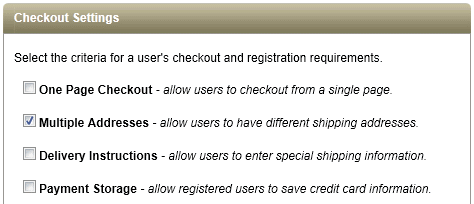
-
The One Page Checkout option will replace the step-by-step checkout system with a single page. It supports all features except the delivery to multiple addresses. If this option is selected from the One page checkout, then the user is brought to the standard checkout pages. NEW in R7
-
The Multiple Addresses option allows the merchant to enable and disable the customer's ability to provide more than one shipping address per order. NEW in R7
-
If you enable Delivery Instructions, then a special field will appear within the shipping method selection area of checkout. The merchant can view the information entered here from the order shipments page. However, it is not supported or sent to any of the shipping gateways you may be using. NEW in R6
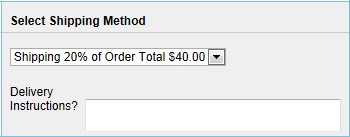
-
The Payment Storage feature is only available with the Authorize.net CIM payment gateway. It allows the customer to store their credit card profiles so checkout will be faster for them in the future. This feature is only available for registered users. NEW in R9
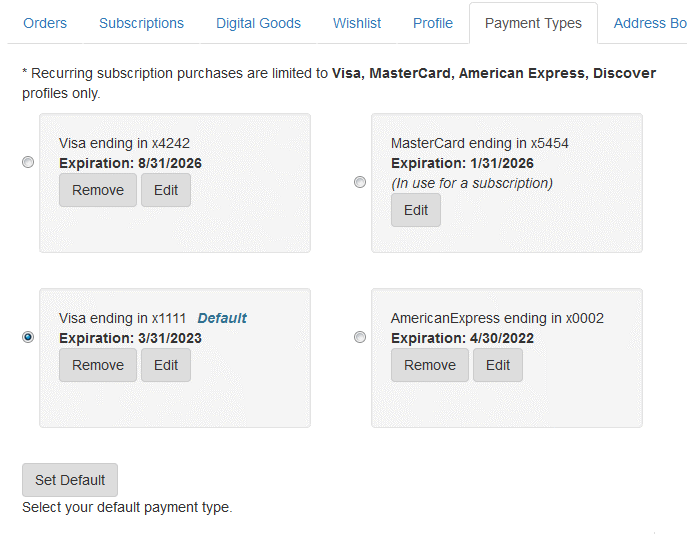
Each payment profile will appear on a new page within their customer account pages. The Payment Types page will show each credit card that is stored. The customer may set a default credit card which will be shown as first choice for their next checkout session. An expired card will be indicated as expired. -
To edit a stored profile, click the EDIT button. The customer can update the stored profile by entering a new expiration date and CVV code. [NEW in R12]
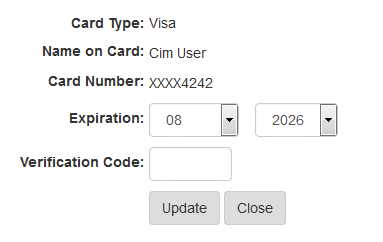
-
Customers may also remove credit card profiles or add new ones from this page using the form provided. All information is securely stored with the payment gateway, and meets PCI compliance.
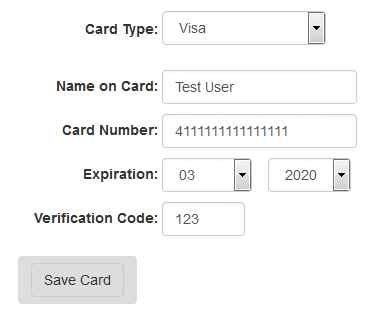
-
Click the SAVE button when finished.
Guest Checkout
If you want to enable or disable the Guest Checkout option, then use one of the three available choices.

When enabled, a new option will be available during the checkout process. New customers will be given the option to checkout without creating a user account. An email address is stored with the order, but a valid user account is not created.
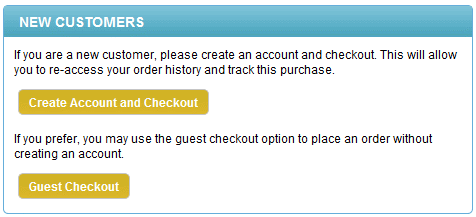
There are three checkout options available for Guest accounts -
-
The option to Enable for all users and order types will allow any customer with any type of product to checkout without having to register for a new account.
-
If you are selling digital goods or subscriptions, there is an option for a Limit to user that are not ordering digital goods or subscriptions. When this is option is enabled, the setting will not allow unregistered users from checking out. Registered users with accounts can return to the store and re-access order information or digital downloads. We recommend that you use this as the default setting.
-
If you use the Disable for all users option, then the Guest Checkout feature will be disabled and all new customers must register for an account by creating a password.
Order Payments
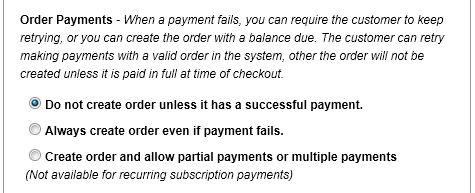
There are three settings to determine how new orders will be created. Each is described below -
-
The default setting is Do not create order unless it has a successful payment. When this setting is active, the order will not be created until the customer has either entered a valid credit card or input a valid payment method. If the card entered fails the authorization, then a warning message will appear asking the customer to enter valid payment information. This setting is generally ignored if you have payment methods such as purchase order, mail check, or call me.
-
The Always create order even if payment fails option can be used to allow a customer to create an order even if their payment fails authorization. The merchant will see the failed order and be able to contact the customer for a different payment method. Additionally, the customer will be presented an invoice with a balance due. From there, they can continue attempting to make a successful payment until the number of tries is exceeded.
NOTE: If you allow the customer to make multiple attempts at payment, the order number will increment for each attempt resulting in the appearance of skipped order numbers from the Order Manager page. -
The final option to Create order and allow partial payments or multiple payments will present the customer with an editable field where they can enter their own payment amount if different than the order total. This can be a useful feature if the customer needs to use multiple payment methods to pay for the order. When this option is used, an initial successful payment is required to create the order receipt. Once that is done, the customer will have the option to continue making multiple payments until the order is paid.
-
Click the SAVE button when finished.
Checkout Terms & Conditions
The Checkout Terms & Conditions field is used if you want the customer to agree to the information you enter here before they can complete an order. Leave this field blank if you do not want to enforce any terms and conditions.
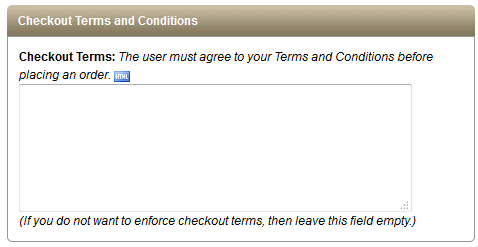
As shown in this example, the user will be presented a link and a checkbox that states they accept your terms and conditions. This information appears on the checkout page.

The user must check the I have read and agree to terms and conditions of ordering box before they can place the order.